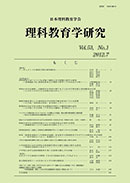
- Issue 3 Pages 1-
- Issue 2 Pages 1-
- Issue 1 Pages 1-
- |<
- <
- 1
- >
- >|
-
Kazumi SHIBA2003Volume 43Issue 3 Pages 1-12
Published: March 05, 2003
Released on J-STAGE: June 30, 2022
JOURNAL FREE ACCESSThe purpose of this paper is to examine the use of CIE educational films and their influence on science education reform in occupied Japan. Through the study of documentary records and interviews with the persons involved, the following results were reached: 1. The CIE educational films were produced by the U. S. A., England, Japan, etc. The CIE educational film "Beware of Fire" was made from part of the CIE educational film "Chemistry of Fire." The former, a film with educational merit, compared favorably with the latter. 2 . The CIE educational films "Beware of Fire" and "Chemistry of Fire" not only helped to make up for the lack of textbooks at elementary and lower secondary schools, but also met the social needs of fire prevention. 3. The use of the CIE educational films promoted the development of high quality educational materials. 4. Discussions following the CIE educational films with the study-discussion guide were promoted by the CIE, the Local Military Government Sections, and the Ministry of Education. 5. Showing the CIE educational films was an opportunity to establish prefectural audiovisual libraries and promoted audio-visual education in science.
View full abstractDownload PDF (1571K) -
Yasuo SAITOH, Yoshiharu TOKUNAGA2003Volume 43Issue 3 Pages 13-20
Published: March 05, 2003
Released on J-STAGE: June 30, 2022
JOURNAL FREE ACCESSThe principal focus of previous practical research on "Scientific Thinking Power" has been mostly on how to use "Process Skills" in science teaching. In this study, "Scientific Thinking" is considered from the perspective of "Scientific Viewpoints" rather than that of "Process Skills." To develop scientific thinking power, we propose a teaching method including "Scientific Viewpoints," which means ways of looking at natural things themselves. And we tried to evaluate the educational effect of our method in practical lessons. "Scientific Viewpoints" are shown as the following eight items, "The Eyes of Scientist," which can be utilized by pupils : (1) What did we do with that? (2) How did we do that?(3) What has changed? (4) What happened to it as a result? (5) What is the difference between these two? (6) What is the cause? What is the effect? (7) What is the relation between the two? (What influence does it have on that?) (8) What are the key points? "The Eyes of a Scientist" method was found to be effective in the problem solving process of science teaching and thereby help develop "Scientific Thinking."
View full abstractDownload PDF (917K) -
Toyokazu USUI, Shizuo MATSUBARA, Tetsuo HORI2003Volume 43Issue 3 Pages 21-28
Published: March 05, 2003
Released on J-STAGE: June 30, 2022
JOURNAL FREE ACCESSThe purpose of this study is to investigate how the group discussion by students in their experiment activities of upper secondary school influences their scientific thinking. In view of the changes in their descriptions before and after their group discussion and their self-evaluation of the discussion and the transcript, it was possible to observe the following: (1) The number of students who could explain their conclusions on the basis of results increased after the group discussion, and their descriptions became more logical. (2) Almost all the students, including not only those students who were taught but also those who taught, felt that their own thoughts were deepened through the group discussion. (3) It was possible to grasp how the group discussion was conducted in the experiment activities by means of recording the discussion for the purpose of self-evaluation. (4) Categorical analysis of the transcripts revealed the basis of the self-evaluation and its reliability. (5) Selecting appropriate teaching materials for experiments fostered active group discussions.
View full abstractDownload PDF (888K)
-
Etsuji YAMAGUCHI, Miwa IKARI, Kazushige MIZOBE, Shigenori INAGAKI, Tom ...2003Volume 43Issue 3 Pages 29-40
Published: March 05, 2003
Released on J-STAGE: June 30, 2022
JOURNAL FREE ACCESSThe purpose of this study is to propose a prototype of a new in-service science teachers training program using IT networks. The newly-developed program focuses on the use of concept maps in science classes. This paper describes the details of the program and the process of developing that. The program are based on educational practices at Akashi Elementary School, which is attached to the Faculty of Human Development, Kobe University. Digital data used in the program consists of video clips of the classes, commentaries or text outlines describing each of the video clips, and pictures of concept maps drawn up by students. There are three stages of the program : introduction, application, and development. In the introduction stage, merits of concept maps and the way of drawing them are explained. The application stage focuses on the science classes using concept maps and their lesson plans. In the development stage, trainees make lesson plans by themselves based on knowledge and experience in the introduction and the application stages. The program contents consist of the following: (1) Introduction; (2) How to make a concept map ; (3) Case example using concept maps (a) (lesson version) : Whole class makes one concept map; (4) Case example using concept maps (a) (explanation version) ; (5) Case example using concept maps (b) (lesson version): Each student draws his/her own concept map; (6) Case example using consept maps (b) (explanation version) ; (7) Task : Lesson plan based on concept maps drawn by students; (8) References of concept maps.
View full abstractDownload PDF (1633K)
- |<
- <
- 1
- >
- >|